
After a turbulent couple of years in the energy sector, most people were expecting coal and gas use to increase. However, things seem to be bouncing back—for electricity, at least.
A recent report has found that renewables met all growth in global electricity demand for the first half of 2022.
From the COVID-19 pandemic to the rebounding economy and the impact of Russia’s invasion of Ukraine, let’s find out what’s affected the fluctuating growth and decline of renewable resource usage for energy demand. That, and what the future holds for the electricity sector.
Key Takeaways: - Global electricity demand growth was met entirely by renewable power in the first half of 2022, halting the rise in fossil fuels. - Renewable energy generation increased by 416 terawatt hours during this time—which means they met 107% of the demand increase. - Wind and solar generation met 77% of this demand growth, while hydro made up the rest.
What Is Considered a Sufficient Level of Electricity?
According to the International Energy Agency (IEA), access to basic electricity means a household should be able to access and afford:
- Power for four lightbulbs five hours a day
- Running a refrigerator
- Power to charge a mobile device or operate a television for four hours a day
- A fan running for six hours a day
This equates to an annual electricity consumption of 1,250 kWh with standard appliances (or 420 kWh with efficient appliances).
Side note: A kilowatt hour (kWh) measures how much energy we use in our homes. 1 kWh is the amount of energy you’d use if you ran a 1,000-watt appliance for an hour.
Compare this to the monthly figures per household in each state—the US average coming in at 900 kWh.
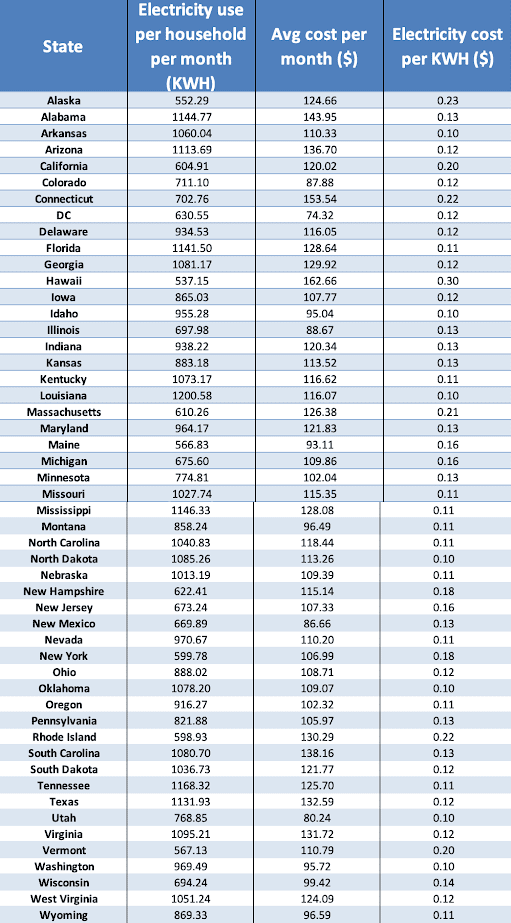
These huge numbers show just how much strain is being put on electricity grids every second. So, what’s powering them?
Related Reading: How Many Solar Panels Would It Take to Power the US?
Renewables Trended Towards Meeting Electricity Demand Increases in 2019
Renewable electricity comes from a power generation source that won’t run out. The most common renewable sources are:
- Solar power: Solar PV (photovoltaic) panels capture sunlight and convert it to electricity in a joint chemical and physical reaction.
- Wind power: Offshore and onshore wind farms generate electricity by spinning the blades of wind turbines.
- Hydropower: Hydroelectric power plants create electricity using falling or flowing water through underwater turbines that turn a generator. These can also rely on natural ocean forces that use wave or tidal power.
- Bioenergy: Electricity can be generated when organic matter is burned as a fuel source (e.g. plants, wood, and food waste). Bioenergy results in CO2 emissions but is considered renewable because it absorbs as much carbon as it emits across its lifespan and can be regrown.
- Geothermal: Heat generated by the Earth’s core can be used to produce power after being run through geothermal power plants.
These forms of green and clean energy are essential to slow the effects of climate change and greenhouse gas emissions. But what percentage of renewables met electricity demand in 2019?
The renewable energy transition has been picking up steam for years. In 2019, almost 30% of the world’s electricity came from renewables.
Here’s the breakdown:
- 15.9% was from hydropower
- 5.9% came from wind power
- Solar PV made up 2.8%
- 2.2% was bio-powered
- 0.4% was a mix of geothermal, CSP (concentrating solar power that uses mirrors), and ocean power
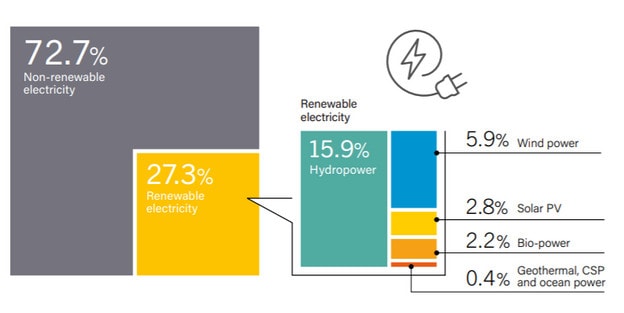
Image credit: IHA
Renewable energy grew 3x faster than fossil fuels and nuclear over a five-year period up until 2019. It also had a record-breaking year in 2019 as installed power capacity grew more than 200 gigawatts (GW)—mostly from solar PV.
In parts of China, the European Union (EU), India and the US, building new wind or solar PV plants became cheaper than operating existing coal-fired power plants. Renewables were also the cheapest sources of new electricity generation in countries across all continents (excluding Antarctica).
Although several key places drove these trends, renewable power was growing in all corners of the world. Globally, 32 countries had at least 10 GW of renewable power installed capacity in 2019. Only 19 of those countries had that much renewable energy in the previous decade.
COVID-19 Impact on Electricity Demand
Energy consumption drastically changed in 2020 due to global lockdowns and governmental restrictions following the spread of COVID-19. Overall demand lowered for commercial buildings, exports, and manufacturing sectors. However, energy use in the housing sector increased by as much as 30% during the full 2020 lockdown period.
Global electricity demand fell by around 1% in 2020. This was most prominent in the first half of the year due to lockdowns restricting commercial and industrial activity. At times, demand was 20-30% lower than pre-lockdown periods.
Data for countries representing more than one-third of global electricity demand showed that every month of full lockdown reduced demand by 20% on average. Global demand decreased by 2.5% in the first quarter of 2020, while demand for coal fell by nearly 8% and oil by 5%.
Here’s the change in weekly electricity demand for select countries over 2020:

Image credit: IEA
Renewables were the only source to record demand growth during this time because of low operating costs and preferential access to electricity networks.
By mid-2020, the power sector of major markets was able to accommodate huge changes in the energy mix. The share of supply met by renewable generation reached historic highs in China, Europe, India and the US. In China, wind power generation increased by 1% while solar increased by 12%.
In the EU and UK, renewables delivered 46% of all power generation (up 8% from 2019) by mid-2020. Renewable energy also reached a record share (an estimated 29%) of the global electricity mix.
A Rebounding Global Economy and Fossil Fuels
With easing government restrictions and accelerated vaccine rollouts, global economies began to rebound in 2021. Electricity generation increased by 6.2%—similar to figures seen in 2010 in the aftermath of the 2008 financial crisis (6.4%).
A record 315 GW of new renewable power capacity was added globally in 2021—that’s enough to power every household in Brazil.
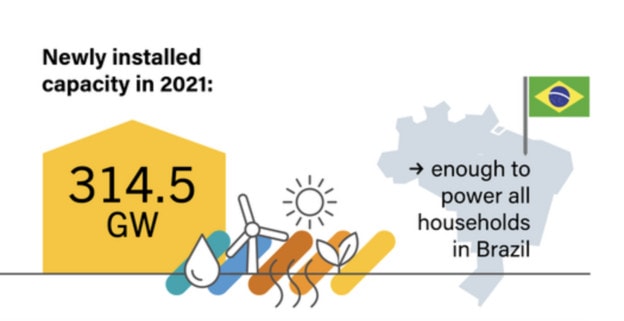
Image credit: REN21
Wind and solar also reached a 10.2% share of power generation. This was the first time wind and solar power provided more than 10% of global power and surpassed nuclear energy’s contribution.
Side note: A terawatt hour (TWh) is another unit of energy that expresses the amount of produced energy, electricity and heat (1 TWh = 1,000,000,000 kWh.)
Power generation from solar PV increased by a record 179 TWh in 2021 (22% more than 2020). This solar energy comprised 3.6% of the world’s electricity generation.
Despite the growth of these sustainable energy sources, coal consumption grew over 6% in 2021 (slightly above 2019 levels and its highest level since 2014) to meet post-lockdown demand.
Carbon emissions also increased due to the rebound in economic growth.

Image credit: BP
Renewable energy was making waves, but emissions were skyrocketing. So, how did 2022 change things?
The Impact of Russia’s Invasion of Ukraine on Electricity Demand
In late February 2022, Russian forces invaded Ukraine in a move that instantly upset the world’s supply chain and revealed the West’s dependency on Russia and Eastern Europe for raw materials and energy.
Some countries, like the UK, were already in the midst of gas shortages at the end of 2021 due to increased use post-COVID. By the end of December last year, a total of 28 energy companies had gone bust.
The sharp rise in the prices of commodities and supply shortages since has hit many economies hard. The International Energy Agency (IEA) called it “the first truly global energy crisis, with impacts that will be felt for years to come”.
Russia is one of the world’s top three crude producers, alongside Saudi Arabia and the US. It’s also the second-largest producer of natural gas (behind the US) and is the world’s largest exporter, with the highest global gas reserves.
Total energy price has risen dramatically since last year. High fuel costs account for 90% of the rise in average costs for electricity generation worldwide.
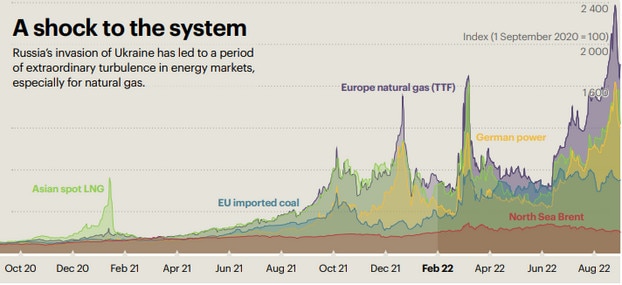
Image credit: World Economic Forum
The impact of the global pandemic and energy crisis brought on by this invasion means 70 million people who recently gained access to electricity can no longer afford it.
To prevent shortfalls of supply, IEA member countries released 62.7 million barrels of emergency oil stocks in March and a further 120 million barrels in April.
Supplies of natural gas delivered by pipeline from Russia have hugely fallen as countries have partially cut off and sanctioned Putin. However, liquefied natural gas (LNG) imports from Russia into the EU have increased by 46% (year-on-year in the first nine months of 2022.)
The World Economic Forum stated, “One potentially positive aspect of higher fossil fuel prices is they provide strong reasons to accelerate towards sustainable alternatives. That said, the need for energy security may prompt further investment in fossil fuel projects.”
So, how does this affect the future of renewable electricity and sustainability? According to the IEA, the crisis is pushing renewable energy projects forward instead of backward. Affected countries have had to quickly create new energy policies regarding electricity supply to make up for any fossil fuel loss.
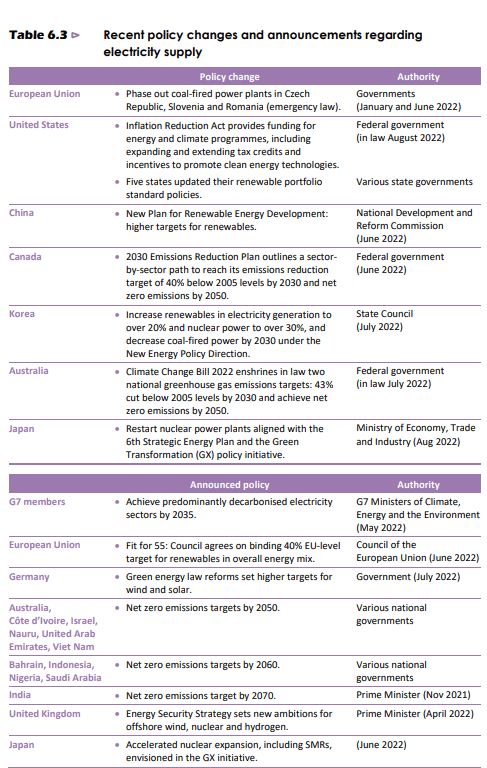
There’s a renewed focus on net zero emissions targets as well as shorter-term bills and law reforms.
In terms of the US response, The Center for Strategic & International Studies said: “The U.S. is the world’s largest oil and gas producer. We can guarantee energy security for the planet and our allies by producing more. But doing so without sacrificing climate outcomes will require careful planning, decent regulation, and a significant effort to reduce our own emissions, build a clean export energy economy – clean energy export economy.”
The Bounce-Back of Renewable Energy for Electricity Demand
It would seem like 2022 wouldn’t be a great year for renewables, but new data is showing otherwise. (As most reports and studies are reflective, this is one of the most recent stats we have.)
According to nonprofit think tank Ember, “Global electricity demand growth was met entirely by renewable power in the first half of 2022, halting the rise in fossil fuels.” The report, written by Senior Electricity Analyst Malgorzata Wiatros-Motyka, surprised many people.
https://twitter.com/EmberClimate/status/1577524083352281088
During the first six months of the year, electricity demand increased by 389 terawatt hours (3% compared to the same timeframe last year.) Renewable energy generation increased by 416 terawatt hours during this time—which means they met 107% of the demand increase.
Wind and solar generation met 77% of this demand growth, while hydro made up the rest. In China, wind and solar power met 92% of its electricity demand rise. This figure was 81% in the US and 23% in India.
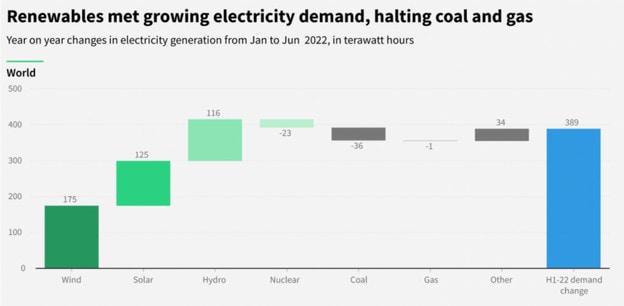
Image credit: Ember
The growth in these renewable resources in the first half of 2022 stopped a 4% increase in fossil generation. This means they avoided 40 billion USD in fuel costs and 230 million tonnes of carbon dioxide emissions.
- In China, fossil fuel power fell by 3% instead of rising by 1%
- In India, the rise in fossil fuel power was slowed from 12% to 9%
- In the US, the rise in fossil fuel power reduced from 7% to 1%
- In the EU, it prevented a major rise in fossil fuel power—6% instead of 16%
Global sales of electric vehicles have also risen strongly in 2022—2 million cars were sold in the first quarter (up 75% from the same period in 2021).
While these still use fossil fuels as part of their electricity mix for manufacturing and charging, the amount depends on location. In the UK, for example, renewable’s share of power generation rose to 38.6%.
While this is all good news, there’s still a problem. Despite all this positive growth, the power sector’s CO2 emissions in 2022 may still rise further than last year’s all-time high due to China’s hydro surplus becoming a deficit because of record droughts and heatwaves that have pushed up electricity demand.
What Does the Future Hold for Renewables and Electricity Demand?
While there have been several major global events and barriers to the growth of renewable energy production, the electricity sector is prevailing. All of these knocks to the supply chain have shown just how much more needs to go into renewables to make them a secure and long-term alternative.
Unfortunately, we’re still at record highs for energy supply emissions. So, we need major changes from governments and leaders to cut these drastically. But these renewable energy sources are proving that they can be an effective alternative for electricity generation if we put the time and effort into transitioning.
Read Next:




